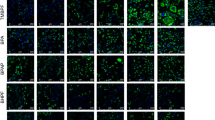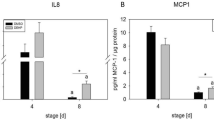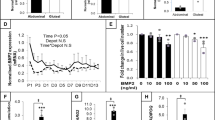Abstract
Background/objectives
Polybrominated diphenyl ethers (PBDEs) are chemicals that were added to consumer products to reduce flammability but were deemed toxic and bioaccumulative and were phased out of commerce. Flame retardants (FRs) such as Dechlorane Plus (DP) were introduced as replacements. DP is being produced in high volumes and is detected in the environment, human milk, and human serum. Although human exposure to DP is evident, little is known about its potential effects on human health. We and others have shown that some FRs are potential obesogens, i.e., promote adipogenesis. However, the effects of DP on adipogenesis are not known.
Methods
Murine 3T3-L1 and human primary subcutaneous (Sc) and omental (Om) preadipocytes were differentiated in the presence of DP (0.001–10 µM) and adipogenic effects were measured. Further, the ability of DP to activate the adipogenic transcription factor peroxisome proliferator-activated receptor γ (PPARγ) was also assessed.
Results
We show that treatment of murine preadipocytes with DP significantly (p < 0.05) increased lipid accumulation (2.5-fold) and the mRNA expression of adipogenic markers: fatty acid binding protein 4 (Fabp4), lipoprotein lipase (Lpl), perilipin (Plin), adipsin, and adiponectin. DP also significantly (p < 0.05) increased the protein levels of selected mature adipocyte markers. We further show using luciferase reporter assays that DP increased PPARγ transcriptional activity by threefold (p < 0.05). When the PPARγ agonist was replaced by DP in the human preadipocyte differentiation cocktail, DP significantly (p < 0.05) increased the mRNA levels of adipogenic markers, PPARγ, FABP4, and PLIN in human Sc as well as Om cultures. Finally, PPARγ antagonist studies revealed that DP-mediated upregulation of adipogenic markers Fabp4 and Lpl did not occur via PPARγ activation.
Conclusion
The current study shows that DP can induce adipogenesis of murine and human preadipocytes. We show that, although DP can directly activate PPARγ, its adipogenic effects may be mediated via other pathways.
This is a preview of subscription content, access via your institution
Access options
Subscribe to this journal
Receive 12 print issues and online access
$259.00 per year
only $21.58 per issue
Buy this article
- Purchase on Springer Link
- Instant access to full article PDF
Prices may be subject to local taxes which are calculated during checkout






Similar content being viewed by others
References
Dodson RE, Perovich LJ, Covaci A, Van den Eede N, Ionas AC, Dirtu AC, et al. After the PBDE phase-out: a broad suite of flame retardants in repeat house dust samples from California. Environ Sci Technol. 2012;46:13056–66.
Siddiqi MA, Laessig RH, Reed KD. Polybrominated diphenyl ethers (PBDEs): new pollutants-old diseases. Clin Med Res. 2003;1:281–90.
Stapleton HM, Allen JG, Kelly SM, Konstantinov A, Klosterhaus S, Watkins D, et al. Alternate and new brominated flame retardants detected in U.S. house dust. Environ Sci Technol. 2008;42:6910–6.
Fan X, Kubwabo C, Rasmussen PE, Wu F. Non-PBDE halogenated flame retardants in Canadian indoor house dust: sampling, analysis, and occurrence. Environ Sci Pollut Res Int. 2016;23:7998–8007.
Zheng XB, Luo XJ, Zeng YH, Wu JP, Mai BX. Sources, gastrointestinal absorption and stereo-selective and tissue-specific accumulation of Dechlorane Plus (DP) in chicken. Chemosphere. 2014;114:241–6.
Ren N, Sverko E, Li YF, Zhang Z, Harner T, Wang D, et al. Levels and isomer profiles of dechlorane plus in Chinese air. Environ Sci Technol. 2008;42:6476–80.
Wang DG, Yang M, Qi H, Sverko E, Ma WL, Li YF, et al. An Asia-specific source of dechlorane plus: concentration, isomer profiles, and other related compounds. Environ Sci Technol. 2010;44:6608–13.
Hoh E, Zhu L, Hites RA. Dechlorane plus, a chlorinated flame retardant, in the Great Lakes. Environ Sci Technol. 2006;40:1184–9.
Sverko E, Tomy GT, Reiner EJ, Li YF, McCarry BE, Arnot JA, et al. Dechlorane plus and related compounds in the environment: a review. Environ Sci Technol. 2011;45:5088–98.
Sverko E, Tomy GT, Marvin CH, Zaruk D, Reiner E, Helm PA, et al. Dechlorane plus levels in sediment of the lower Great Lakes. Environ Sci Technol. 2008;42:361–6.
Xian Q, Siddique S, Li T, Feng YL, Takser L, Zhu J. Sources and environmental behavior of dechlorane plus--a review. Environ Int. 2011;37:1273–84.
Siddique S, Xian Q, Abdelouahab N, Takser L, Phillips SP, Feng YL, et al. Levels of dechlorane plus and polybrominated diphenylethers in human milk in two Canadian cities. Environ Int. 2012;39:50–5.
Ren G, Yu Z, Ma S, Li H, Peng P, Sheng G, et al. Determination of Dechlorane Plus in serum from electronics dismantling workers in South China. Environ Sci Technol. 2009;43:9453–7.
Zheng J, Wang J, Luo XJ, Tian M, He LY, Yuan JG, et al. Dechlorane Plus in human hair from an e-waste recycling area in South China: comparison with dust. Environ Sci Technol. 2010;44:9298–303.
Zoeller RT, Brown TR, Doan LL, Gore AC, Skakkebaek NE, Soto AM, et al. Endocrine-disrupting chemicals and public health protection: a statement of principles from The Endocrine Society. Endocrinology. 2012;153:4097–110.
Tung EWY, Ahmed S, Peshdary V, Atlas E. Firemaster(R) 550 and its components isopropylated triphenyl phosphate and triphenyl phosphate enhance adipogenesis and transcriptional activity of peroxisome proliferator activated receptor (Ppargamma) on the adipocyte protein 2 (aP2) promoter. PLoS ONE. 2017;12:e0175855.
Tung EWY, Peshdary V, Gagne R, Rowan-Carroll A, Yauk CL, Boudreau A, et al. Adipogenic effects and gene expression profiling of Firemaster(R) 550 components in human primary preadipocytes. Environ Health Perspect. 2017;125:097013.
Pillai HK, Fang M, Beglov D, Kozakov D, Vajda S, Stapleton HM, et al. Ligand binding and activation of PPARgamma by Firemaster(R) 550: effects on adipogenesis and osteogenesis in vitro. Environ Health Perspect. 2014;122:1225–32.
Grun F, Blumberg B. Environmental obesogens: organotins and endocrine disruption via nuclear receptor signaling. Endocrinology. 2006;147(6 Suppl):S50–5.
Farmer SR. Transcriptional control of adipocyte formation. Cell Metab. 2006;4:263–73.
Li X, Ycaza J, Blumberg B. The environmental obesogen tributyltin chloride acts via peroxisome proliferator activated receptor gamma to induce adipogenesis in murine 3T3-L1 preadipocytes. J Steroid Biochem Mol Biol. 2011;127:9–15.
Peshdary V, Gagnon A, Sorisky A. Effect of high glucose concentration on human preadipocytes and their response to macrophage-conditioned medium. Can J Diabetes. 2016;40:411–8.
Greenspan P, Mayer EP, Fowler SD. Nile red: a selective fluorescent stain for intracellular lipid droplets. J Cell Biol. 1985;100:965–73.
Kim JB, Wright HM, Wright M, Spiegelman BM. ADD1/SREBP1 activates PPARgamma through the production of endogenous ligand. Proc Natl Acad Sci USA. 1998;95:4333–7.
Frohnert BI, Hui TY, Bernlohr DA. Identification of a functional peroxisome proliferator-responsive element in the murine fatty acid transport protein gene. J Biol Chem. 1999;274:3970–7.
Fan C, Yan J, Qian Y, Wo X, Gao L. Regulation of lipoprotein lipase expression by effect of hawthorn flavonoids on peroxisome proliferator response element pathway. J Pharmacol Sci. 2006;100:51–8.
Ahmed S, Atlas E. Bisphenol S- and bisphenol A-induced adipogenesis of murine preadipocytes occurs through direct peroxisome proliferator-activated receptor gamma activation. Int J Obes (Lond). 2016;40:1566–73.
Rosen ED, MacDougald OA. Adipocyte differentiation from the inside out. Nat Rev Mol Cell Biol. 2006;7:885–96.
Holtcamp W. Obesogens: an environmental link to obesity. Environ Health Perspect. 2012;120:a62–8.
Shin J, Li B, Davis ME, Suh Y, Lee K. Comparative analysis of fatty acid-binding protein 4 promoters: conservation of peroxisome proliferator-activated receptor binding sites. J Anim Sci. 2009;87:3923–34.
Schoonjans K, Gelman L, Haby C, Briggs M, Auwerx J. Induction of LPL gene expression by sterols is mediated by a sterol regulatory element and is independent of the presence of multiple E boxes. J Mol Biol. 2000;304:323–34.
Boucher JG, Ahmed S, Atlas E. Bisphenol S induces adipogenesis in primary human preadipocytes from female donors. Endocrinology. 2016;157:1397–407.
Patel P, Abate N. Body fat distribution and insulin resistance. Nutrients. 2013;5:2019–27.
Heindel JJ, Newbold R, Schug TT. Endocrine disruptors and obesity. Nat Rev Endocrinol. 2015;11:653–61.
Feo ML, Baron E, Eljarrat E, Barcelo D. Dechlorane Plus and related compounds in aquatic and terrestrial biota: a review. Anal Bioanal Chem. 2012;404:2625–37.
Acknowledgements
Thank you to the patients and surgeons of The Ottawa Hospital for human adipose tissue samples.
Author information
Authors and Affiliations
Corresponding author
Ethics declarations
Conflict of interest
The authors declare that they have no conflict of interest.
Electronic supplementary material
Rights and permissions
About this article
Cite this article
Peshdary, V., Calzadilla, G., Landry, A. et al. Dechlorane Plus increases adipogenesis in 3T3-L1 and human primary preadipocytes independent of peroxisome proliferator-activated receptor γ transcriptional activity. Int J Obes 43, 545–555 (2019). https://doi.org/10.1038/s41366-018-0072-7
Received:
Revised:
Accepted:
Published:
Issue Date:
DOI: https://doi.org/10.1038/s41366-018-0072-7



